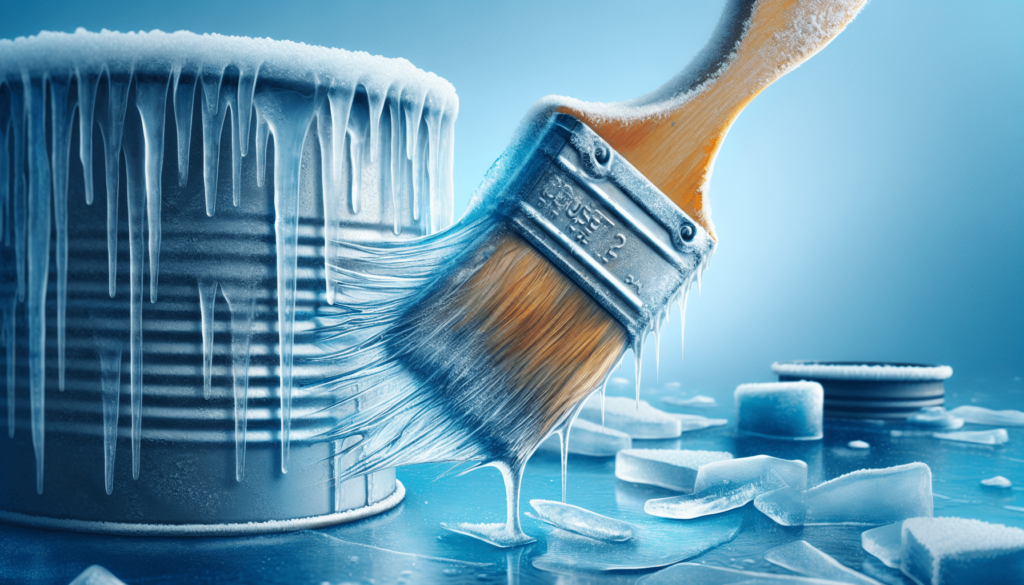If you have ever faced the issue of frozen latex paint, then you know the frustration it can cause. Fortunately, there are ways to salvage your frozen latex paint and restore it to its original usable state. In this article, you will learn effective techniques and precautions to take when dealing with frozen paint. By following these steps, you can save both your paint and money, while ensuring the quality of your future painting projects remains uncompromised.

Why Save Frozen Latex Paint
Frozen latex paint can be saved for several reasons, including its environmental impact and the potential financial savings it offers. By properly thawing and reviving frozen paint, you can not only prevent waste but also contribute to a healthier and cleaner environment. Additionally, saving frozen latex paint allows you to maximize the use of your resources, saving you money in the long run.
Assessing the Frozen Latex Paint
Before attempting to save frozen latex paint, it is crucial to assess its condition. This assessment involves checking the consistency, clumps, and odor of the paint.
Check the Consistency
When latex paint freezes, it can often become inconsistent in texture. Before thawing the paint, examine its consistency. If it appears lumpy or has separated into layers, it may be more challenging to salvage. However, if the consistency appears relatively uniform, you can proceed with the thawing process.
Check for Clumps
Inspect the frozen paint for any clumps that may have formed during freezing. These clumps can indicate that the paint has already undergone a dramatic change in composition, making it difficult to restore. If the clumps are minimal and easily breakable, there is a higher chance of successfully saving the paint.
Check for Odor
Frozen paint that has developed a strong, unpleasant odor is likely no longer usable. A foul smell can indicate that the paint has started to spoil or undergo chemical changes, rendering it unsuitable for future use. If there is no strong odor, proceed with thawing and testing the paint.
Thawing the Frozen Latex Paint
Thawing the frozen latex paint properly is crucial to restore its original consistency and performance. There are several methods you can use to accomplish this.
Room Temperature Thawing
One simple method to thaw frozen latex paint is to allow it to sit at room temperature. Place the sealed paint container in a cool and dry area for several hours or overnight. This gradual thawing process allows the paint to return to its original state without causing any significant alterations to its composition.
Warm Water Bath Thawing
For a quicker thawing process, you can use a warm water bath. Fill a basin or sink with warm (not hot) water and submerge the sealed paint container in the water. Make sure the water level is below the lid and allow the paint to thaw for several minutes. Gently agitate the container to aid the thawing process, ensuring that the water does not penetrate the container and mix with the paint.
Shake It Up
After thawing the paint using either method, it is essential to shake the container vigorously to mix any separated particles thoroughly. The freezing process can cause latex paint to separate, with the pigment settling at the bottom. Shaking the container helps to recombine the components and restore the paint’s original consistency.
Testing the Paint After Thawing
Once the frozen latex paint has thawed, it is essential to test its quality and suitability for future use. This testing process involves mixing the paint, checking for proper consistency, and assessing its smooth application.
Mix Thoroughly
After thawing and shaking the paint container, open it and visually inspect the paint. Look for any remaining clumps or separation within the paint. Use a clean stir stick or paint mixing tool to thoroughly mix the paint until it appears consistently smooth throughout.
Check for Proper Consistency
During the mixing process, pay attention to the paint’s consistency. It should have a creamy texture that is neither too thick nor too runny. If the paint appears too thin or watery, it may require further additives or adjustments before use. Conversely, if it is too thick, some water or paint thinner may be necessary to achieve the desired consistency.
Check for Smooth Application
To determine if the thawed paint is suitable for use, apply a small amount to a test surface using a paintbrush or roller. Assess how smoothly the paint applies and if it adheres well to the surface. The paint should spread evenly without leaving streaks or clumps. If the paint does not meet these criteria, further adjustments or disposal may be necessary.

Reviving Dried-up Paint
In addition to saving frozen paint, you may also encounter dried-up paint that needs to be revived. Fortunately, there are methods that can help restore dried paint to a usable state.
Removing the Dried Top Layer
Before attempting to revive dried paint, it is crucial to remove any dried top layer or skin. Use a paint strainer or a mesh screen to filter the dried chunks or particles, ensuring a smooth application of the revived paint.
Adding Water
To revive dried latex paint, water is often the primary additive used. Start by adding a small amount of water to the dried paint and stirring it thoroughly. Gradually add more water, mixing well after each addition until the paint reaches the desired consistency. However, be cautious not to add too much water, as this can dilute the paint and affect its quality.
Using Paint Additives
In some cases, simply adding water may not be enough to fully revive dried latex paint. Paint additives or conditioners specifically designed for rehydrating paint can be used. These additives help to restore the paint’s original properties and improve its flow and adhesion. Follow the manufacturer’s instructions and recommended ratios when using paint additives for reviving dried paint.
Storing Thawed or Rehydrated Paint
Once the frozen or dried paint has been successfully saved, proper storage is essential to maintain its usability and quality over time.
Use Air-Tight Containers
Transfer the saved paint into clean and airtight containers that are specifically designed for storing paint. Ensure that the lids are tightly sealed to prevent air exposure, which can lead to paint drying out or developing a skin.
Label and Date the Containers
To avoid confusion and ensure easy identification, label each container with the type of paint, color, and date of storage. This information is helpful when retrieving the paint for future projects or determining its shelf life.
Store in a Cool and Dry Place
To prolong the lifespan of saved paint, store the containers in a cool and dry location. Extreme temperature fluctuations or excessive humidity can compromise the paint’s quality and consistency. A basement, garage, or storage area away from direct sunlight and moisture is ideal for long-term paint storage.
Alternative Uses for Unusable Paint
In the event that the thawed or revived latex paint is still not suitable for regular use, there are alternative ways to repurpose it, preventing unnecessary waste.
Donate to Local Art Schools
If the salvaged paint is of decent quality but not suitable for your project needs, consider donating it to local art schools or community centers. Many art programs can benefit from extra supplies, and your unusable paint could be put to creative use by aspiring artists.
Use for DIY Projects
Unusable latex paint can also come in handy for various do-it-yourself (DIY) projects. From small craft projects to furniture refinishing, there are numerous opportunities to utilize paint even when it is not suitable for traditional applications. Get creative and explore different ways to incorporate the paint into your DIY endeavors.
Recycle Responsibly
In cases where the paint is beyond saving or repurposing, it is essential to dispose of it responsibly. Research the proper disposal methods in your local area to ensure that the paint is recycled or disposed of in an environmentally friendly manner. Many communities have dedicated programs or facilities for paint recycling, reducing the negative impact on the environment.
Preventing Freezing in the Future
To avoid encountering frozen latex paint altogether, there are preventive measures you can take to ensure the quality and usability of your paint supply.
Store in Controlled Temperature
Always store latex paint in an environment where the temperature can be controlled. Extreme temperature fluctuations, particularly freezing temperatures, can cause irreversible damage to the paint’s composition. Keep the paint in a temperature-controlled room or storage area to maintain its quality.
Protect from Extreme Cold
If storing paint in an unheated location during colder months, take extra precautions to protect it from extreme cold temperatures. Insulate the containers by placing them inside a box or wrapping them in blankets to provide an extra layer of protection against freezing conditions.
Avoid Long-Term Storage
To maximize the lifespan of latex paint, it is best to avoid long-term storage whenever possible. Paint can deteriorate over time, leading to changes in consistency, color, and overall quality. Try to purchase and use paint in quantities that are appropriate for your project to minimize the need for long-term storage and potential issues with the paint’s performance.
Tips and Precautions
To ensure optimal results when saving frozen or dried paint, consider the following tips and take necessary precautions:
Avoid Repeated Freezing and Thawing
It is best to avoid repeatedly freezing and thawing latex paint, as this can degrade its quality and impact its performance. Once the paint has been thawed and tested, it is advisable to use it within a reasonable period to prevent further deterioration.
Never Use Frozen Paint
Using frozen paint directly without proper thawing and testing can result in poor adhesion, uneven application, and an overall unsightly finish. Always take the time to thaw and assess the paint’s quality before attempting to use it for any project.
Dispose of Unusable Paint Properly
If your attempts to save frozen or dried latex paint are unsuccessful, it is crucial to dispose of it responsibly. Improper disposal, such as pouring paint down the drain or throwing it in regular trash, can harm the environment. Research local regulations and guidelines regarding proper disposal methods to ensure eco-friendly practices.
Conclusion
Saving frozen latex paint offers both environmental and financial benefits. By following the proper thawing and testing techniques, you can restore frozen paint to its original usability. Additionally, reviving dried-up paint provides an opportunity to maximize the use of your resources and minimize waste. With the right storage methods and responsible disposal practices, you can make the most of your paint supply while reducing your impact on the environment. By taking proactive measures to prevent freezing and taking necessary precautions, you can ensure the longevity and quality of your paint, ultimately saving money and contributing to a more sustainable future.



